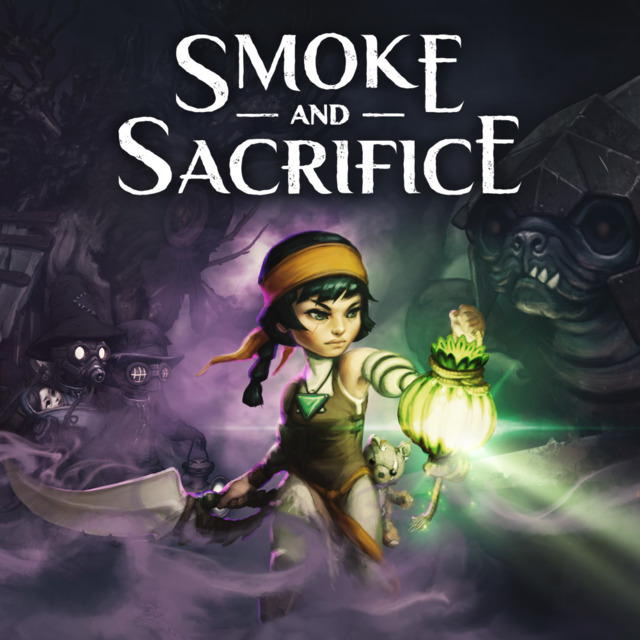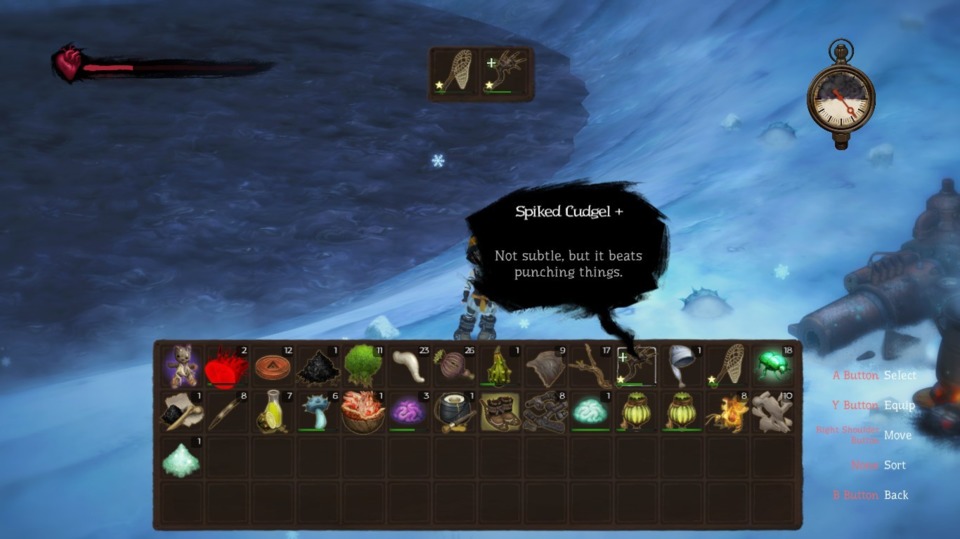Indie Game of the Week 151: Smoke and Sacrifice
By Mento 0 Comments

It's a new year, and a new spate of Indie Game of the Week blogs on some not-so-new Indie games. Smoke and Sacrifice is a middling introduction to the year, as I didn't anticipate how much survival mechanics played a factor in its action-RPG gameplay framework. The game's set in some kind of post-apocalyptic landscape where one of the few surface areas not affected by an endless winter is kept lit and arable by various ancient machines that provide sunlight to the vicinity and allows for crops to grow and a humble agrarian community to flourish. However, this boon comes with a price: every citizen must sacrifice their firstborn to the "Sun Tree" to keep the lights on, and the latest chosen is protagonist Sachi's infant son Lio. This religious ritual is not quite as it seems, however, and seven years after her heartbreaking loss Sachi is finally in a position to figure out the dark secrets literally lying beneath her feet and uncover the conspiracy behind all these "sacrificial" children. It starts with a teleporter that takes her deep underground, filled with toxic smoke and hostile creatures...
The game is loosely a Diablo-like action-RPG with real-time combat in that sort of slanted overhead perspective. Sachi acquires weapons and armor as she explores, and must make judgments about whether or not a nearby opponent is something she is capable of taking on, depending on her gear and current condition. What sets the game apart from most action-RPGs is a very heavy emphasis on crafting and maintenance, making it more akin to a Don't Starve in practice: almost everything needs to be constructed from parts found from all over and several of those items, including all the weapons and the essential lanterns, have endurance that ticks down with their constant use. Many consumable items have limited shelf lives also, especially parts dropped by dead enemies. Items can be mended on the fly and many can be crafted then and there, but the more sophisticated items - meals, equipment, certain key items - can only be made at special crafting stations dotted infrequently around the landscape. The world is separated into "biomes" which have their own assortment of naturally occurring resources, enemies, traps, and hazards - a polar region, for example, needs special shoes to stop Sachi from slipping and is the only place to find ice fungus and bone piles. Though the game has a somewhat open structure, there's always a main questline and several side-quests that the game tracks on your behalf, and will always provide you with some rough idea of a destination to head towards next with its handy map system.

For as survival-heavy as some aspects of the game might be, it's not actually quite as much of a headache as I usually find with others of this genre. For instance, there's no hunger or thirst gauges: every consumable item instead regenerates health and possibly provides a temporary boost to speed, offense, or defense. Many items, like shoes, keys, meals, and inorganic resources, won't decay at all and will safely sit in your inventory in reasonably large stacks until you need them. Others that can go off can be stored in chests to preserve them, and the game is filled with "travel tubes" that allow for instantaneous travel to places you've visited (and, when the story necessitates it, sometimes a place you've yet been), many of which are also strategically next to one or more of the aforementioned storage containers. The quest structure eliminates the usual meandering common to survival games, where it's not clear what you should be doing besides building ever better equipment and shelters, and although the combat is rough going initially by taking the time to explore and finding recipes and ingredients in remote locations you start building up a decent arsenal of tools and weaponry. A useful early find is the formula for smoke grenades, which can be used to slow and weaken groups of smaller enemies that might otherwise swarm you. One persistent annoyance is the game's equivalent of a day/night cycle: being underground, you don't so much worry about darkness than the onset of a thick, venomous fog that rolls in from the toxic sludge that surrounds the subterranean landmass and acts as a hard barrier. When this smoke is active, the player must use some manner of lighting device to keep it away or suffer a steady health loss - there are the lanterns, one of the earliest recipes you find, and eventually you become capable of producing your own light at a mana cost - and stronger enemies start roaming around when the smoke is at its densest. This cycle can change enemy drops and environmental details as well, so even though you could theoretically wait out the smog in a safe haven there are times when you'll need to brave it for specific resources.
I'm finding the game fascinating, even if my progress is only coming in fits and starts. There's a lot of ways you can be killed quickly, either because you wandered into the domain of a foe far too difficult for you right now or because you aren't able to effectively manage your health/light or because of some new trap that you weren't prepared to deal with, but these challenges all provide reasons to press on so you might one day surpass them and see what lies beyond. Wandering off the beaten path can be a death sentence or a shortcut to riches, frequently both depending on how cautiously you approach it, and the vaguely steampunk environments of the underworld are always wonderfully curious places to explore and beautifully rendered by the game's painterly and detailed 2D graphics (they remind me a lot of Broken Age, especially with how "paper doll" the character movements are). It is a game that asks a lot of the player, ultimately, and I don't know for sure if my intrigue about the game and where it's going will necessarily win out over my increasing apathy with each progress-scrubbing game over or tedious cycle of maintenance work. Still, I can appreciate any survival game that uses those mechanics sparingly in the service of more compelling story- and RPG-based goals, rather than the be-all and end-all of the entire game's progression.
Rating: 3 out of 5.
| < Back to 150: GNOG | The First 100 | > Forward to 152: The Haunted Island, a Frog Detective Game |
